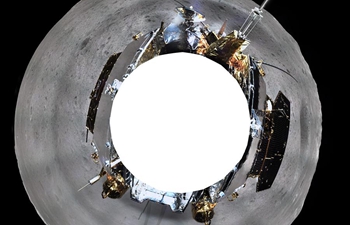LOS ANGELES, Jan. 16 (Xinhua) -- Scientists from NASA's New Horizons mission on Tuesday released new images and a movie of the Kuiper Belt object nicknamed Ultima Thule, the most distant object ever explored.
The movie shows the propeller-like rotation of Ultima Thule in seven hours between 3 p.m. eastern time (2000 GMT) on Dec. 31, 2018 and 12:01 a.m. (0501 GMT) on Jan. 1, 2019.
It was seen by the Long Range Reconnaissance Imager (LORRI) aboard NASA's New Horizons as the spacecraft sped toward its close encounter with the Kuiper Belt object at 12:33 a.m. eastern time (0533 GMT) on Jan. 1.
New Horizons performed this farthest flyby in history when it approached Ultima Thule within 2,200 miles (about 3,540 km) of the surface at a velocity of 31,500 miles (about 50,694 km) per hour.
During this deep-space photo shoot, New Horizons' range to Ultima Thule decreased from 310,000 miles (about 500,000 km) to just 17,100 miles (about 28,000 km), during which the images became steadily larger and more detailed.
All the images have been sharpened by scientific techniques that can enhance details. The original image scale is 1.5 miles (2.5 km) per pixel in the first frame, and 0.08 miles (0.14 km) per pixel in the last frame, according to the team.
The New Horizons science team will use these images to help determine the three-dimensional shape of Ultima Thule in order to better understand its nature and origin.
New Horizons downlinked the two highest-resolution images in this movie immediately after the Jan. 1 flyby, but the more distant images were sent home on Jan. 12-14, after a week when New Horizons was too close to the Sun for reliable communications.
New Horizons will continue to transmit images and data for the next months, said the team.
The New Horizons mission, launched in January 2006, aims to understand worlds at the edge of the solar system by making the first reconnaissance of the dwarf planet Pluto, and by venturing deeper into the distant, mysterious Kuiper Belt -- a relic of solar system formation.













